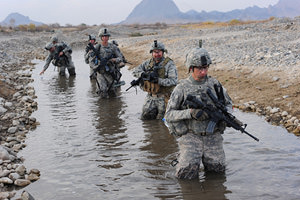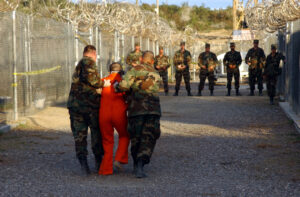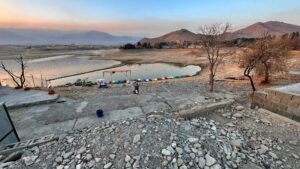It’s No Secret: Afghanistan Is a Quagmire
The tens of thousands of classified military documents posted on the Internet Sunday confirm what critics of the war in Afghanistan already knew or suspected: We are wading deeper into a long-running, morally ambiguous conflict that has virtually no chance of ending well.We don't need WikiLeaks to know we are wading deeper into a long-running, morally ambiguous conflict that has virtually no chance of ending well.
The tens of thousands of classified military documents posted on the Internet Sunday confirm what critics of the war in Afghanistan already knew or suspected: We are wading deeper into a long-running, morally ambiguous conflict that has virtually no chance of ending well.
The Obama administration, our NATO allies and the Afghan government responded to the documents — made public by a gadfly organization known as WikiLeaks — by saying they tell us nothing new. Which is the problem.
We already had plenty of evidence that elements within Pakistan’s intelligence services were giving support and guidance to the Taliban insurgency inside Afghanistan, even though Pakistan is supposed to be our ally in the fight against the terrorists. The newly released documents don’t provide conclusive proof, but they do give a sense of how voluminous the evidence is. “American soldiers on the ground are inundated with accounts of a network of Pakistani assets and collaborators,” according to The New York Times, one of three news organizations — along with The Guardian and Der Spiegel — with which WikiLeaks shared the documents in advance.
We already knew that U.S. and other coalition forces were inflicting civilian casualties that had the effect of enraging local villagers and often driving them into the enemy camp. The documents merely reveal episodes that were previously unpublicized — an October 2008 incident in which French troops opened fire on a bus near Kabul and wounded eight children, for example, and a tragedy two months later when a U.S. squad riddled another bus with gunfire, killing four passengers and wounding 11 others.
We knew that U.S. and allied special forces units were authorized to assassinate senior Taliban or al-Qaida figures. The leaked documents sketch the activities of the secret “kill or capture” unit named Task Force 373 — and in the process, according to The Guardian, “raise fundamental questions about the legality of the killings … and also pragmatically about the impact of a tactic which is inherently likely to kill, injure and alienate the innocent bystanders whose support the coalition craves.”
The Guardian highlights a 2007 incident in which Task Force 373, operating in a valley near Jalalabad, set out to apprehend or kill a Taliban commander named Qarl Ur-Rahman. As the commandos neared the target, someone pointed a flashlight at them; they called for air support, and an AC-130 gunship strafed the area. Later, they discovered that they had killed seven Afghan National Police officers and wounded four others.
A few days later, according to the documents, a Task Force 373 unit fired rockets into a village where they believed a foreign jihadist fighter from Libya was hiding. They killed six Taliban fighters — but also seven civilians, all of them children. One was alive when allied medics arrived. “The Med TM immediately cleared debris from the mouth and performed CPR,” the incident report states, but after 20 minutes the child died.
We knew that the Afghan government was spectacularly corrupt. The documents let us glimpse a bit of that corruption — how commonplace it is and how it destroys public trust.
The documents do tell us some things that we didn’t know — for example, that the Taliban apparently used a heat-seeking missile to shoot down a coalition helicopter in 2007, at a time when U.S. officials were pooh-poohing the threat to allied aircraft from insurgent forces. Underestimating the enemy is rarely a good idea.
And the “Afghan War Diary,” as WikiLeaks calls the documents, brings into clear focus the Catch-22 absurdity of trying to wage counterinsurgency warfare in a nation with a 2,000-year tradition of implacable resistance to foreign invaders. As the White House was quick to point out, the documents cover the period before President Barack Obama ordered an escalation and a change of strategy. Gen. Stanley McChrystal, Obama’s chosen commander, tried his best to limit civilian casualties — but soldiers complained, with some justification, that they were not being allowed to fully engage and pursue the enemy. Gen. David Petraeus, put in charge after McChrystal’s dismissal, is under pressure from the ranks to relax the rules of engagement — which would surely lead to more civilians killed, and more grieving relatives transformed into Taliban sympathizers.
Overall, though, the most shocking thing about the “War Diary” may be that it fails to shock. The documents illustrate how futile — and tragically wasteful — it is to send more young men and women to fight and die in Afghanistan.
But we knew this, didn’t we?
Eugene Robinson’s e-mail address is eugenerobinson(at)washpost.com.
© 2010, Washington Post Writers Group
Your support matters…Independent journalism is under threat and overshadowed by heavily funded mainstream media.
You can help level the playing field. Become a member.
Your tax-deductible contribution keeps us digging beneath the headlines to give you thought-provoking, investigative reporting and analysis that unearths what's really happening- without compromise.
Give today to support our courageous, independent journalists.






You need to be a supporter to comment.
There are currently no responses to this article.
Be the first to respond.